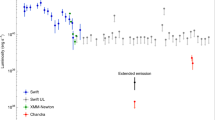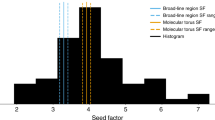Abstract
Black-hole accretion states near or above the Eddington luminosity (the point at which radiation force outwards overcomes gravity) are still poorly known because of the rarity of such sources. Ultraluminous X-ray sources1 are the most luminous class of black hole (LX ≈ 1040 erg s−1) located outside the nuclei of active galaxies. They are likely to be accreting at super-Eddington rates, if they are powered by black holes with masses less than 100 solar masses. They are often associated with shock-ionized nebulae2,3, though with no evidence of collimated jets. Microquasars with steady jets are much less luminous. Here we report that the large nebula S26 (ref. 4) in the nearby galaxy NGC 7793 is powered by a black hole with a pair of collimated jets. It is similar to the famous Galactic source SS433 (ref. 5), but twice as large and a few times more powerful. We determine a mechanical power of around a few 1040 erg s−1. The jets therefore seem 104 times more energetic than the X-ray emission from the core. S26 has the structure of a Fanaroff–Riley type II (FRII-type) active galaxy: X-ray and optical core, X-ray hot spots, radio lobes6 and an optical and X-ray cocoon. It is a microquasar where most of the jet power is dissipated in thermal particles in the lobes rather than relativistic electrons.
This is a preview of subscription content, access via your institution
Access options
Subscribe to this journal
Receive 51 print issues and online access
$199.00 per year
only $3.90 per issue
Buy this article
- Purchase on Springer Link
- Instant access to full article PDF
Prices may be subject to local taxes which are calculated during checkout




Similar content being viewed by others
References
Ward, M. Luminous X-ray sources in spiral and star-forming galaxies. Phil. Trans. R. Soc. Lond. A 360, 1991–2003 (2002)
Pakull, M. W. & Mirioni, L. Optical counterparts of ultraluminous X-ray sources. Preprint at 〈http://arxiv.org/abs/astro-ph/0202488〉 (2002)
Pakull, M. W. & Mirioni, L. Bubble nebulae around ultraluminous X-ray sources. Rev. Mex. Astron. Astrofis. (Ser. Conf.) 15, 197–199 (2003)
Blair, W. P. & Long, K. S. Identification of supernova remnants in the Sculptor galaxies NGC 300 and NGC 7793. Astrophys. J. Suppl. Ser. 108, 261–277 (1997)
Fabrika, S. The jets and the supercritical accretion disk in SS433. Astrophys. Space Phys. Rev. 12, 1–153 (2004)
Pannuti, T. G. et al. An X-ray, optical and radio search for supernova remnants in the nearby Sculptor group Sd galaxy NGC 7793. Astrophys. J. 565, 966–981 (2002)
Pakull, M. W., Grisé, F. & Motch, C. in Populations of High Energy Sources in Galaxies (eds Meurs, E. J. A. & Fabbiano, G.) 293–297 (IAU Symp. 230, Cambridge Univ. Press, 2006)
Pakull, M. W. & Grisé, F. in A Population Explosion: The Nature & Evolution of X-ray Binaries in Diverse Environments (eds Bandyopadhyay, R. M., Wachter, S., Gelino, D. & Gelino, C. R.) 303–307 (AIP Conf. Proc. 1010, American Institute of Physics, 2008)
Karachentsev, I. D. et al. Distances to nearby galaxies in Sculptor. Astron. Astrophys. 404, 93–111 (2003)
Read, A. M. & Pietsch, W. ROSAT observations of the Sculptor galaxy NGC 7793. Astron. Astrophys. 341, 8–22 (1999)
Wilson, A. S., Smith, D. A. & Young, A. J. The cavity of Cyg A. Astrophys. J. 644, L9–L12 (2006)
Clark, J. S. & Crowther, P. A. On the Wolf-Rayet Counterpart to IC 10 X-1. Astron. Astrophys. 414, L45–L48 (2004)
Silverman, J. M. & Filippenko, A. V. On IC 10 X-1, the most massive known stellar-mass black hole. Astrophys. J. 678, L17–L20 (2009)
Lozinskaya, T. A. & Moiseev, A. V. A synchrotron superbubble in the IC 10 galaxy: a hypernova remnant? Mon. Not. R. Astron. Soc. 381, L26–L29 (2007)
Asvarov, A. I. Radio emission from shell-type supernova remnants. Astron. Astrophys. 459, 519–533 (2006)
Allen, M. G., Groves, B. A., Dopita, M. A., Sutherland, R. S. & Kewley, L. J. The MAPPINGS III library of fast radiative shock models. Astrophys. J. Suppl. Ser. 178, 20–55 (2008)
Weaver, R., McCray, R., Castor, J., Shapiro, P. & Moore, R. Interstellar bubbles. II. Structure and evolution. Astrophys. J. 218, 377–395 (1977)
Kaiser, C. R. & Alexander, P. A self-similar model for extragalactic radio sources. Mon. Not. R. Astron. Soc. 286, 215–222 (1997)
Dopita, M. A. & Sutherland, R. S. Spectral signatures of fast shocks. I. Low-density model grid. Astrophys. J. Suppl. Ser. 102, 161–188 (1996)
Begelman, M. C., Hatchett, S. P., McKee, C. F., Sarazin, C. L. & Aarons, J. Beam models for SS433. Astrophys. J. 238, 722–730 (1980)
Begelman, M. C., King, A. R. & Pringle, J. E. The nature of SS433 and the ultraluminous X-ray sources. Mon. Not. R. Astron. Soc. 370, 399–404 (2006)
Bogovalov, S. V. & Kel’ner, S. R. Dissipationless disk accretion. Astron. Rep. 49, 57–70 (2005)
Heinz, S. Radio lobe dynamics and the environment of microquasars. Astron. Astrophys. 388, L40–L43 (2002)
Ito, H., Kino, M., Nozomu, K., Isobe, N. & Shoishi, Y. The estimate of kinetic power of jets in FR II radio galaxies: existence of invisible components? Astrophys. J. 685, 828–838 (2008)
Kennicutt, R. C. Jr et al. An Hα imaging survey of galaxies in the local 11 Mpc volume. Astrophys. J. Suppl. Ser. 178, 247–279 (2008)
Dopita, M. A. & Sutherland, R. S. Astrophysics of the Diffuse Universe 200-204 (Springer, 2003)
Raymond, J. C. et al. Spatial and spectral interpretation of a bright filament in the Cygnus Loop. Astrophys. J. 324, 869–892 (1988)
Acknowledgements
This work was based on observations made with ESO telescopes at the Paranal Observatory under program 084.D-0881 (M.W.P.), and made use of the ESO/ST-ECF Science Archive facility, which is a joint collaboration of the ESO and the Space Telescope European Coordinating Facility. Data were obtained from the Chandra Data Archive and software was provided by the Chandra X-ray Center. R.S. acknowledges support from an Early-Career Leverhulme Fellowship and hospitality at the University of Sydney during part of this work.
Author information
Authors and Affiliations
Contributions
M.W.P. designed the study and analysed the optical spectroscopic observations. R.S. contributed the X-ray spectral analysis and the relative astrometric calibrations of the multiband datasets. C.M. carried out the reductions and analysis of the optical imaging data. All authors discussed the results and made substantial contributions to the manuscript.
Corresponding authors
Rights and permissions
About this article
Cite this article
Pakull, M., Soria, R. & Motch, C. A 300-parsec-long jet-inflated bubble around a powerful microquasar in the galaxy NGC 7793. Nature 466, 209–212 (2010). https://doi.org/10.1038/nature09168
Received:
Accepted:
Issue Date:
DOI: https://doi.org/10.1038/nature09168
Comments
By submitting a comment you agree to abide by our Terms and Community Guidelines. If you find something abusive or that does not comply with our terms or guidelines please flag it as inappropriate.



